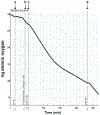Measurement of mitochondrial oxygen consumption using a Clark electrode
- PMID: 22215541
- PMCID: PMC8711122
- DOI: 10.1007/978-1-61779-504-6_5
Measurement of mitochondrial oxygen consumption using a Clark electrode
Abstract
Mitochondria require oxygen to produce ATP in sufficient quantities to drive energy-requiring reactions in eukaryotic organisms. The measurement of oxygen consumption rates from isolated mitochondria in vitro is a useful and valuable technique in the research and evaluation of mitochondrial dysfunction and disease since ADP-dependent oxygen consumption directly reflects coupled respiration or oxidative phosphorylation (OXPHOS). This chapter describes the traditional method of mitochondrial polarography using a Clark electrode for measuring coupled respiration in freshly isolated mitochondria from both mammalian tissues and Drosophila melanogaster.
Figures



Similar articles
-
Assessing Mitochondrial Bioenergetics by Respirometry in Cells or Isolated Organelles.Methods Mol Biol. 2018;1732:273-287. doi: 10.1007/978-1-4939-7598-3_18. Methods Mol Biol. 2018. PMID: 29480482
-
Evaluation of Respiration with Clark-Type Electrode in Isolated Mitochondria and Permeabilized Animal Cells.Methods Mol Biol. 2018;1782:7-29. doi: 10.1007/978-1-4939-7831-1_2. Methods Mol Biol. 2018. PMID: 29850992
-
Evaluation of Respiration with a Clark-Type Electrode in Isolated Mitochondria, Intact and Permeabilized Cells, and Explants from Animal Tissues.Methods Mol Biol. 2025;2878:1-34. doi: 10.1007/978-1-0716-4264-1_1. Methods Mol Biol. 2025. PMID: 39546254
-
In vivo and in organello assessment of OXPHOS activities.Methods. 2002 Apr;26(4):307-16. doi: 10.1016/S1046-2023(02)00036-1. Methods. 2002. PMID: 12054921 Review.
-
Mitochondrial Neurodegeneration: Lessons from Drosophila melanogaster Models.Biomolecules. 2023 Feb 16;13(2):378. doi: 10.3390/biom13020378. Biomolecules. 2023. PMID: 36830747 Free PMC article. Review.
Cited by
-
Macromitophagy is a longevity assurance process that in chronologically aging yeast limited in calorie supply sustains functional mitochondria and maintains cellular lipid homeostasis.Aging (Albany NY). 2013 Apr;5(4):234-69. doi: 10.18632/aging.100547. Aging (Albany NY). 2013. PMID: 23553280 Free PMC article.
-
Mitochondria as the Target of Hepatotoxicity and Drug-Induced Liver Injury: Molecular Mechanisms and Detection Methods.Int J Mol Sci. 2022 Mar 18;23(6):3315. doi: 10.3390/ijms23063315. Int J Mol Sci. 2022. PMID: 35328737 Free PMC article. Review.
-
Measurement of Oxygen Consumption Rate (OCR) and Extracellular Acidification Rate (ECAR) in Culture Cells for Assessment of the Energy Metabolism.Bio Protoc. 2018 May 20;8(10):e2850. doi: 10.21769/BioProtoc.2850. eCollection 2018 May 20. Bio Protoc. 2018. PMID: 34285967 Free PMC article.
-
Effects of arginine on coenzyme-Q10 micelle uptake for mitochondria-targeted nanotherapy in phenylketonuria.Drug Deliv Transl Res. 2024 Jan;14(1):191-207. doi: 10.1007/s13346-023-01392-x. Epub 2023 Aug 9. Drug Deliv Transl Res. 2024. PMID: 37555905
-
Cleavage kinetics of human mitochondrial RNase P and contribution of its non-nuclease subunits.Nucleic Acids Res. 2023 Oct 27;51(19):10536-10550. doi: 10.1093/nar/gkad713. Nucleic Acids Res. 2023. PMID: 37779095 Free PMC article.
References
-
- Chance B, and Williams GR (1955) A simple and rapid assay of oxidative phosphorylation, Nature 175, 1120–1121. - PubMed
-
- Barrientos A (2002) In vivo and in organello assessment of OXPHOS activities, Methods 26, 307–316. - PubMed
-
- Trounce IA, Kim YL, Jun AS, and Wallace DC (1996) Assessment of mitochondrial oxidative phosphorylation in patient muscle biopsies, lymphoblasts, and transmitochondrial cell lines, Methods Enzymol 264, 484–509. - PubMed
-
- Bradford MM (1976) A rapid and sensitive method for the quantitation of microgram quantities of protein utilizing the principle of protein-dye binding, Anal Biochem 72, 248–254. - PubMed
MeSH terms
Substances
Grants and funding
LinkOut - more resources
Full Text Sources
Molecular Biology Databases

